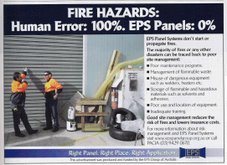
It has been suggested that it was New Zealand’s largest food processing firestorm in history. The Tegel Poultry Processing Plant in the Christchurch suburb of Hornby was devastated on 5 January, 2007 in a conflagration the like of which fire fighters attending rarely see.
Polystyrene panels have been implicated in this tragedy which left the company scrambling for temporary space, under attack from animal rights activists, and paying fulltime salaries to staff with no work to do.
The Tegel fire set records. The total losses are estimated to be between NZ$50m and NZ$100m. The fire also broke records for the number of appliances attending. “Ten fire engines and more than 50 firefighters were called to the blaze, meaning every available firefighter in the city was on site,” said a news report.
The Fire Brigades’ Regional Commander Rob Saunders said: "They were supported by a number of firefighters from volunteer brigades from surrounding areas and call back staff were called back in to provide fire coverage for the Christchurch district."
TV New Zealand was on the spot to record the dramatic inferno. “The fire-fighters were battling 20m-high flames, the fire’s ferocity kept the first ground crew at a distance. They took to their new multi million dollar aerial towers.”
“With the flames came thick dark smoke fuelled by polystyrene that plumed over much of the western and southern city and precinct,” said the report.
The pure heat of the fire was such the investigation was delayed: “Fire safety officer Sue Trafford says the site examination has taken much longer than expected because the factory was so badly damaged,” said the television report.
The fire performance of polystyrene insulated panel in New Zealand was part of the New Zealand Fire Service’s Research Priorities for 2002/2003. It’s recommendation included the following: “Polystyrene Insulated Panel (PIP) has been used as a building material in New Zealand for over thirty years… There is growing concern, however, about the fire performance of the material within New Zealand and overseas. “ (http://www.fire.org.nz/research/reports/2002-2003.htm)
“The Hornby plant was a 24hour operation, killing 50 thousand chickens a day, mostly for the local market. It has more than 300 employees, half of them employed on the processing line that was destroyed,” reported One News.
Tegel's only South Island poultry slaughterhouse came under attack from SAFE, New Zealand's second largest animal advocacy organization. "Tegel's slaughterhouse operation in Hornby kills about 50,000 chickens each day. The massive backlog of chickens awaiting slaughter could cause serious welfare problems and result in increased bird mortalities," said Hans Kriek, campaign director of SAFE.
“The poultry industry has purposely produced a meat chicken that has an accelerated growth rate that allows the birds to be ‘table ready' at a mere six weeks of age. Their unnaturally large bodies place enormous strain on the birds' legs resulting in abnormal gait, lameness and pain.
"The destruction of the slaughterhouse could cause a delay in killing these fast-growing birds, which will increase the level of suffering. Tegel has publicly stated that their focus is on staff and customers but SAFE calls on them to ensure their priorities include the tens of thousands of animals also affected," says Mr Kriek.
"SAFE is concerned the poultry industry's contingency for emergency slaughter could result in compromised humane slaughter procedures. If the birds are forced to remain on farms for prolonged periods or transported to the North Island for slaughter, systems must be in place to mitigate as much suffering as possible".
In response, TVNZ reported that “Tegel group chief financial officer Rob Aitken says Tegel will work with the Poultry Industry Association in a bid to find alternative plant in order to keep the operation running.”
Despite the reports, the polystyrene industry in New Zealand still maintains it is a safe material. However, in a report titled “Effect of Heat on EPS” Plastics New Zealand admits the following: “As EPS is heated it softens, and at about 150ºC it begins to shrink. This continues until it is reduced to its original density prior to expansion. Continued heating will melt it to liquid and then a combustible gas will form above 200ºC. This gas can be ignited at temperatures between 360ºC and 380ºC, and will self ignite around 500ºC. When burning, it produces 40 - 45 MJ/Kg of heat. Temperatures of this magnitude usually occur only in well-developed fires.”
